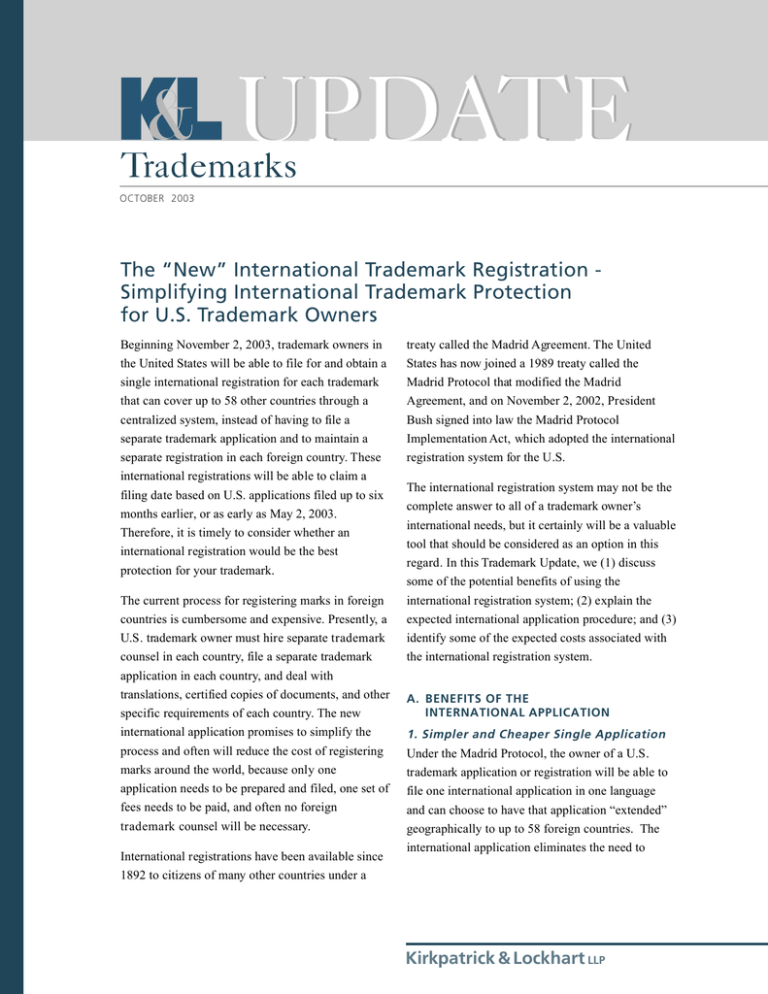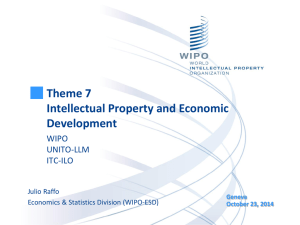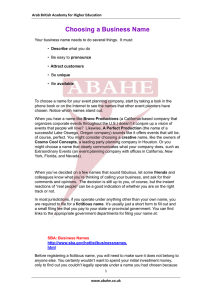
UPDATE
Trademarks
OCTOBER 2003
The “New” International Trademark Registration Simplifying International Trademark Protection
for U.S. Trademark Owners
Beginning November 2, 2003, trademark owners in
the United States will be able to file for and obtain a
single international registration for each trademark
that can cover up to 58 other countries through a
centralized system, instead of having to file a
separate trademark application and to maintain a
separate registration in each foreign country. These
international registrations will be able to claim a
filing date based on U.S. applications filed up to six
months earlier, or as early as May 2, 2003.
Therefore, it is timely to consider whether an
international registration would be the best
protection for your trademark.
The current process for registering marks in foreign
countries is cumbersome and expensive. Presently, a
U.S. trademark owner must hire separate trademark
counsel in each country, file a separate trademark
application in each country, and deal with
translations, certified copies of documents, and other
specific requirements of each country. The new
international application promises to simplify the
process and often will reduce the cost of registering
marks around the world, because only one
application needs to be prepared and filed, one set of
fees needs to be paid, and often no foreign
trademark counsel will be necessary.
International registrations have been available since
1892 to citizens of many other countries under a
treaty called the Madrid Agreement. The United
States has now joined a 1989 treaty called the
Madrid Protocol that modified the Madrid
Agreement, and on November 2, 2002, President
Bush signed into law the Madrid Protocol
Implementation Act, which adopted the international
registration system for the U.S.
The international registration system may not be the
complete answer to all of a trademark owner’s
international needs, but it certainly will be a valuable
tool that should be considered as an option in this
regard. In this Trademark Update, we (1) discuss
some of the potential benefits of using the
international registration system; (2) explain the
expected international application procedure; and (3)
identify some of the expected costs associated with
the international registration system.
A. BENEFITS OF THE
INTERNATIONAL APPLICATION
1. Simpler and Cheaper Single Application
Under the Madrid Protocol, the owner of a U.S.
trademark application or registration will be able to
file one international application in one language
and can choose to have that application “extended”
geographically to up to 58 foreign countries. The
international application eliminates the need to
Kirkpatrick & Lockhart LLP
MADRID PROTOCOL MEMBER COUNTRIES*
Albania
Antigua and Barbuda
Armenia
Australia
Austria
Belarus
Belgium
Bhutan
Bulgaria
China
Cuba
Czech Republic
Democratic People’s
Republic of Korea
Denmark
Estonia
Finland
France
Georgia
Germany
Greece
Hungary
Iceland
Ireland
Italy
Japan
Kenya
Latvia
Lesotho
Liechtenstein
Lithuania
Luxembourg
Monaco
Mongolia
Morocco
Mozambique
Netherlands
Norway
Poland
Portugal
Republic of Korea
Republic of Moldova
Romania
Russian Federation
Serbia and Montenegro
Sierra Leone
Singapore
Slovakia
Slovenia
Spain
Swaziland
Sweden
Switzerland
The former Yugoslav
Republic of Macedonia
Turkey
Turkmenistan
Ukraine
United Kingdom
Viet Nam
* As of 10/08/03. In November 2003, Cyprus and the United States will be added to this list. Iran will be added in
December 2003. Unofficial reports indicate that the European Union may join the Madrid Protocol in the near future.
Source: World Intellectual Property Organization website, www.wipo.int/madrid/en.
prepare and file multiple applications and to hire
trademark lawyers in each separate country to file
applications. Because there is only one application,
only one set of official and attorney’s fees will be
required to file in multiple countries.
2. Simpler and Cheaper
Single Registration Maintenance
If the international application is successful, it will
result in one international registration with one
registration number and one renewal date covering
every country to which the application was
successfully extended. The registration can later be
extended to provide protection in any of the
countries not previously chosen. Modifications to the
international registration such as amendments,
changes of address, assignments, or renewals can be
filed in a central location, and the necessity for
multiple amendments is avoided.
3. Faster Access to National Protection
A request to extend either an international
application or an international registration to a
particular country must be examined and acted upon
by that country within eighteen months or it
automatically receives protection as if it were
registered in that country on the date the extension
was requested. This is a much shorter time frame
than many countries provide for foreign applications
filed directly with their national office.
4. Earlier and Easier Filing Date and Priority
The filing date of an international registration, which
is important for determining priority between
conflicting users of a mark, is the date on which the
international application is filed with the U.S. PTO,
as long as the application is received by the central
Madrid Protocol office within two months of filing
Kirkpatrick
& Lockhart
LLP LLP
Kirkpatrick
& Lockhart
2
2
and meets the requirements set out for an
international registration. The Madrid Protocol also
allows the applicant to claim a priority filing date for
its international application based on a U.S.
application filed within the previous six months.
B. HOW THE MADRID PROTOCOL WORKS
To utilize the Madrid Protocol in the U.S., the
applicant must be a national of, be domiciled in, or
have a real and effective industrial or commercial
establishment in the U.S. The applicant must own a
U.S. trademark registration or application, which is
called the “basic” application or registration. The
application process is as follows:
1. Filing the Application
The applicant must file the international application
with the U.S. PTO as a separate application from the
basic U.S. application or registration and must
identify the basic U.S. application or registration on
which the international application is based. The
mark in the international application must be
identical to the mark in the basic application or
registration, and the list of goods and services must
be identical to or narrower than those in the basic
application or registration. The applicant must
designate at least one foreign country to which it
seeks to extend protection and must pay the
appropriate filing fees (see below).
2. Processing by the U.S. PTO
After receiving the international application, the U.S.
PTO will then forward the application to the
International Bureau of the World Intellectual
Property Organization (“WIPO”) in Geneva,
Switzerland, along with a certification of the date
that the international application was filed in the
U.S. PTO and a certification that the international
application is the same as the U.S. application or
registration on which it is based. If the international
application is received by WIPO within two months,
the date that the international application is properly
International Application Procedure
▼
▼
Applicant
International
Application
(Based on U.S.
Application or
Registration)
U.S. PTO
▼
International
Application and
Certification
▼
Foreign
Trademark
Office
▼
▼
Foreign
Trademark
Office
▼
International
Register
▼
Foreign
Trademark
Office
WIPO
Kirkpatrick
& Lockhart
LLP LLP
Kirkpatrick
& Lockhart
3
3
filed in the U.S. PTO will be the filing date of the
international registration. If not, then the filing date
is the date that WIPO receives it.1
The applicant can claim priority based on the basic
U.S. application if the international application is
filed within six months of the basic U.S. application,
in which case the filing date of the international
registration is the filing date of the basic U.S.
application. For example, if the international
application is filed November 2, 2003, and the U.S.
PTO sends it to WIPO before January 2, 2004, then
November 2, 2003 is the filing date. If the applicant
had filed its basic application on May 2, 2003 and
claimed priority on that basic application, then
May 2, 2003 is the filing date of the international
application.
3. Examination of the Application by WIPO
Once WIPO receives the international application, it
follows a two-step examination process. First, it
evaluates whether the application meets the
international application filing requirements. If the
application doesn’t conform to the requirements,
WIPO will contact either the trademark owner or the
U.S. PTO. If the requirements are met, WIPO places
the mark on the register and publishes it in the WIPO
Gazette of International Marks. Second, WIPO
forwards the registration information to the foreign
countries that the applicant has designated. The
trademark owner is not limited to its initial selection
of countries, but can also request to extend the
geographical reach of its international registration to
additional member countries at a later date.
4. Examination by the National Offices
Each designated foreign country then proceeds to
examine the application on the basis of its own
national law and must respond to the applicant
within 18 months. At this point the national office
may request additional information or responses to
office actions. Responding to the foreign national
trademark office, when necessary, is the only portion
of the application process that will likely require the
applicant to obtain foreign trademark counsel.
5. Maintaining an International Registration
The international registration lasts for ten (10) years
and can be renewed for additional ten-year periods
by making one filing in the U.S. PTO. However, for
the first five (5) years the international registration
remains dependent on the continuing validity and
scope of the basic U.S. application or registration.
During this five-year period, any cancellation or
limitation of the basic U.S. application or
registration will also apply to all rights obtained in
other member countries under the international
registration. However, even under these
circumstances, the owner can maintain its foreign
rights. The Madrid Protocol provides trademark
owners with the option to convert rights under an
international registration into corresponding national
rights by instituting national filings within three
months of the cancellation or limitation to the
original U.S. application or registration. These new
national filings receive the same priority date as the
previous international registration for that country.
Any future enforcement of the mark in a particular
country using the international registration must be
done in that country under the substantive and
procedural laws of that country.
C. INTERNATIONAL APPLICATION FEES
Each of the administering bodies and government
agencies may charge separate fees related to
processing the international application. Although
these fees can become significant, the overall cost
will likely be less than filing individual applications
in each separate country. These fees include the
following:
1 Because the U.S. PTO must forward the international application to WIPO within two months, the U.S.
PTO will require that any international application filed in the U.S. PTO be filed electronically.
Kirkpatrick & Lockhart LLP
4
The U.S. PTO, WIPO, and the individual
countries all charge additional fees for more
complex applications.
■
The U.S. PTO will charge $100 per international
class per application for certifying an
international application to WIPO.
■
■
WIPO charges three fees for a basic application:
(1) an application fee of approximately $458, (2)
a supplementary fee of approximately $52 for
each international class over three, and (3) a
complementary fee of approximately $52 for each
country designated.
These fees are all set in Swiss francs and therefore
are subject to changes in exchange rates. However,
all of these fees can be paid to the U.S. PTO in U.S.
currency at one time upon filing the international
application.
■
Approximately 22 individual countries set their
own complementary fee instead of WIPO’s
complementary fee – for instance, among the
higher fees are: the United Kingdom at
approximately $271, Australia at approximately
$279, and China at approximately $242.
FRANKLIN B. MOLIN
fmolin@kl.com
412.355.6251
KIMBERLY L. NASH
knash@kl.com
412.355.8245
If you would like to discuss any of these issues in greater detail, please contact any one of
*As of 4/30/03.
Source:K&L
World
Intellectual
Property Organization
website, www.wipo.int/madrid/en
the following
Trademark
& Copyright
Group lawyers:
Boston
Dallas
Harrisburg
Los Angeles
Miami
Newark
New York
Pittsburgh
San Francisco
Washington
Arthur Z. Bookstein
Robert Everett Wolin
Carleton O. Strouss
Paul W. Sweeney, Jr.
Daniel A. Casey
Anthony P. La Rocco
Anthony H. Handal
Franklin B. Molin
Deborah Bailey-Wells
Stephen C. Glazier
617.261.3153
214.939.4909
717.231.4503
310.552.5055
305.539.3324
973.848.4014
212.536.4870
412.355.6251
415.249.1065
202.778.9045
abookstein@kl.com
rwolin@kl.com
cstrouss@kl.com
psweeney@kl.com
dcasey@kl.com
alarocco@kl.com
ahandal@kl.com
fmolin@kl.com
dbaileywells@kl.com
sglazier@kl.com
®
Kirkpatrick & Lockhart LLP
Challenge us. ®
www.kl.com
BOSTON
■
DALLAS
■
HARRISBURG
■
LOS ANGELES
■
MIAMI
■
NEWARK
■
NEW YORK
■
PITTSBURGH
■
SAN FRANCISCO
■
WASHINGTON
.........................................................................................................................................................
This publication/newsletter is for informational purposes and does not contain or convey legal advice. The information herein
should not be used or relied upon in regard to any particular facts or circumstances without first consulting a lawyer.
LLP. ALL RIGHTS RESERVED.
© 2003 KIRKPATRICK & LOCKHART
Kirkpatrick & Lockhart LLP
5
75 State Street
Boston, Massachusetts 02109
617.261.3100 PHONE
617.261.3175 FAX
2828 North Harwood Street
Suite 1800
Dallas, Texas 75201
214.939.4900 PHONE
214.939.4949 FAX
Payne Shoemaker Building
240 North Third Street
Harrisburg, Pennsylvania 17101
717.231.4500 PHONE
717.231.4501 FAX
10100 Santa Monica Boulevard
Seventh Floor
Los Angeles, California 90067
310.552.5000 PHONE
310.552.5001 FAX
Miami Center - 20th Floor
201 South Biscayne Boulevard
Miami, Florida 33131
305.539.3300 PHONE
305.358.7095 FAX
The Legal Center
One Riverfront Plaza, Seventh Floor
Newark, New Jersey 07102
973.848.4000 PHONE
973.848.4001 FAX
599 LexingtonAvenue
New York, New York 10022
212.536.3900 PHONE
212.536.3901 FAX
Henry W. Oliver Building
535 Smithfield Street
Pittsburgh, Pennsylvania 15222
412.355.6500 PHONE
412.355.6501 FAX
Four Embarcadero Center, 10th Floor
San Francisco, California 94111
415.249.1000 PHONE
415.249.1001 FAX
1800 Massachusetts Avenue, N.W.
Second Floor
Washington, DC 20036
202.778.9000 PHONE
202.778.9100 FAX
®
www.kl.com
Kirkpatrick & Lockhart LLP
Challenge us.
Kirkpatrick & Lockhart LLP
6
®




